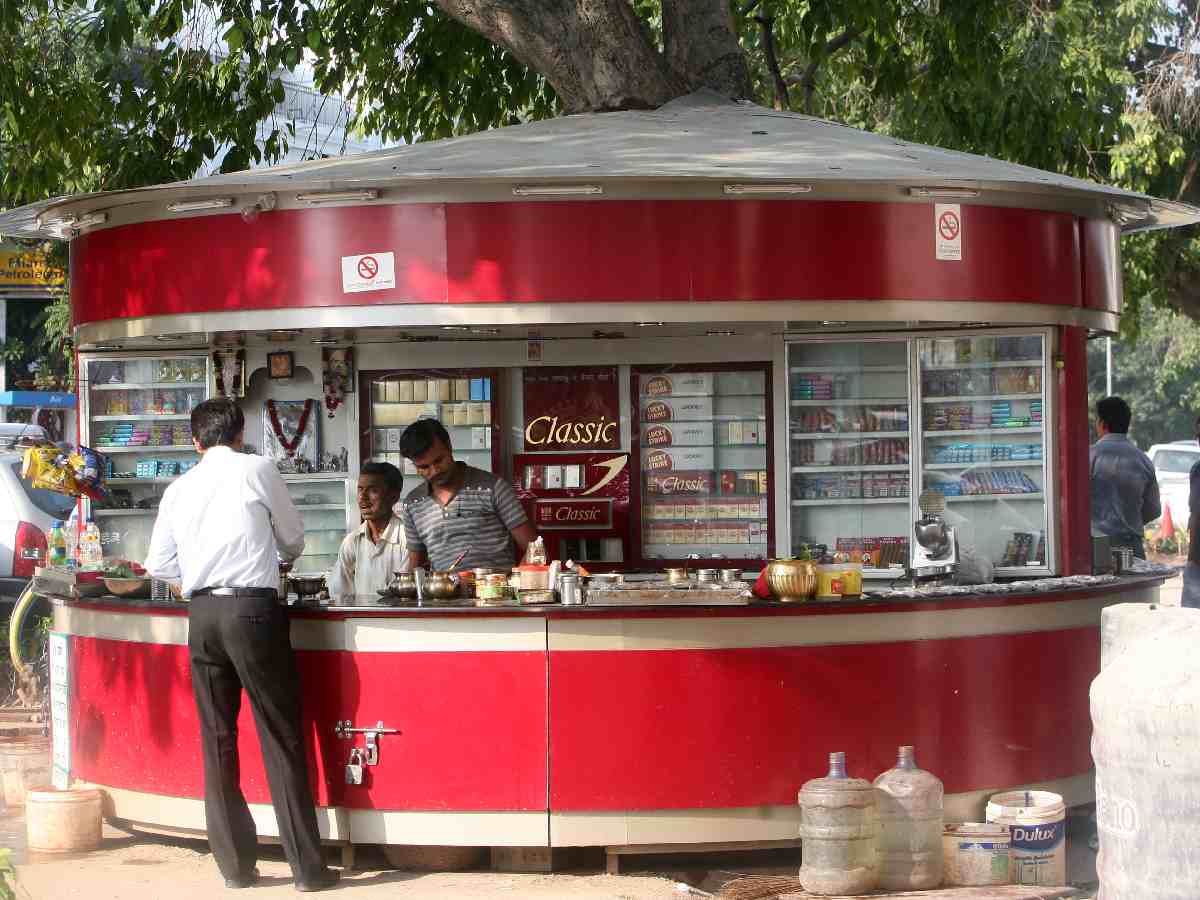Away from the acrimonious discussions on social media, some real-life friends and neighbours quietly discuss local issues outside their favourite paanwala’s shop at Sita Ram Bazar in Delhi-6. It is around 9 pm, and the walled city is bustling with activity. Mishra, the paanwala, takes his time preparing paans for his customers. For some, he also provides packets of paan, known as ‘beeda’ in local parlance. The customers change every few minutes, and as Mishra makes paans, he shares his views on every subject under the sun.
Mishra is a relatively new paanwala here, and his knowledge of the paan trade is shaped by the stories of old masters like Bundu, who once dominated the scene. Bundu was legendary among paan lovers—once you tried his paan, you wouldn’t consider going anywhere else. Bundu’s stall was near Jama Masjid, in Urdu Bazaar, close to the now closed Jagat Cinema. Bundu was a wrestler who used locally grown betel leaves to prepare his paans. “One bite of Bundu’s paan, and you were transported to a state of bliss.

Bundu sold paan for about 40 years and communicated with customers mostly through gestures. If a regular customer suggested how to make the paan, he felt humiliated,” recalls businessman Ashu Bhai, who used to buy paan from Bundu.
Like all paanwalas, Bundu believed he knew the preferences of all his patrons. After Bundu, his son ran the shop but eventually abandoned the business.
Also read: Delhi police constable’s tragic death leaves family struggling for survival and justice
Tilak Ram Paanwala of Kucha Pati Ram
Could the paan lovers of Kucha Pati Ram in Sita Ram Bazar and nearby areas like Chawri Bazar, Nai Sarak, and Turkman Gate ever forget the taste and fragrance of Tilak Ram’s paans? Tilak Ram served hundreds of paans daily, along with just as many paan ‘beedas’ (packets). His beedas were delivered to shops and offices in Chawri Bazaar, Sita Ram Bazaar, and Asaf Ali Road from early morning. Dressed in a white kurta-pyjama, Tilak Ram insisted that no one could jump the queue. A key to his success was happily giving paans on credit to his loyal customers. Old-timers in Sita Ram Bazaar say that Tilak Ram’s son didn’t continue his father’s business. He studied at Delhi Public School and took up a corporate job.
Credit key to success
A paanwala who offers credit is destined for success, they say. Knowing his customers’ preferences was crucial. Paan lovers proudly share, “So-and-so paanwala knows my preferences.” Senior journalist S Jha remains indebted to a paanwala outside the All India Radio building at Sansad Marg. “I will not disclose his name, as he asked me not to. He used to give paans on credit to dozens of people, though this generosity was limited to paan buyers only. Cigarettes and paan masala required cash. Once, I was short of Rs. 30,000 to buy my flat. It was the late 1980s, and that was a huge sum. One day, while standing with him, I told him about my grim situation. He assured me I would get the money. I thought he was merely being friendly, but the next day, he handed me a packet. It contained Rs 30,000, and he told me to go pay for my flat.”
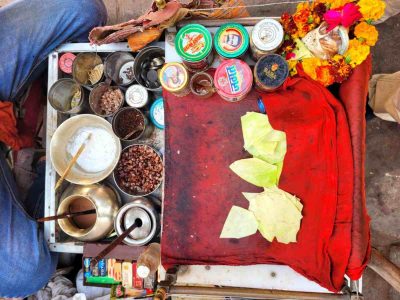
The wandering Paanwalas
Have you heard of the wandering paanwalas? In areas like Chandni Chowk, Fatehpuri, and Dariba Kalan, you’ll find these paanwalas carrying baskets filled with betel leaves, containers of kattha (catechu), chuna (lime), supari (areca nut), gulukand (rose petal jam), saunf (fennel seeds), and more. These wandering paanwalas hail from eastern Uttar Pradesh or Bihar. They keep moving, sometimes settling temporarily, but without a fixed stall. This means that the lively atmosphere around established paan shops is missing.
Nanhe has no regular shop in Connaught Place. He moves around to sell his paans, and despite living in Delhi for over three decades, he has no regrets about not owning a shop. “I cannot change my destiny. It’s fine that I sell on the move. I earn enough to feed my family,” he says. During wedding seasons, they receive orders from families or banquet halls to prepare paans for guests, earning Rs 15,000 to Rs 20,000 per event.
Paan from Sindhi Paanwalas
After the partition of India, many Sindhi Hindus, including Sindhi paanwalas, migrated from Sindh, Pakistan, to Delhi. They brought the flavour of Sindhi paan with them. Tikamchand Lalwani, who came from Karachi, opened the first Sindhi paan shop in Delhi, on Darya Ganj Main Road. His simple leaf, betel nut, and sweet paans gained immense popularity. He never compromised on quality, buying ingredients like khaavara, fennel seeds, and areca nut himself. Inspired by his success, many young Sindhis opened their own paan shops in Delhi, each carving out their own niche.
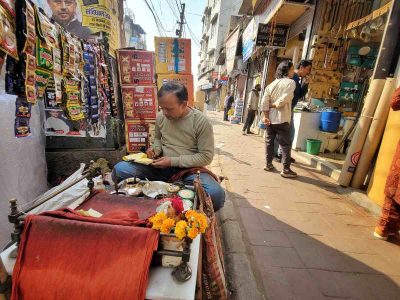
What is special about Sindhi Paan
One unique thing about Sindhi paan is that it doesn’t stain the mouth red or require spitting. The Sindhi paanwalas enjoy long conversations with their customers, discussing national and international issues. If you visit a Sindhi paanwala, take your time. They dislike customers dictating how their paans should be made, often saying, “Sahib, this is unfair. I know your preference. Perhaps you haven’t even recognised me.” They insist on making your paan perfectly but at their pace.
Sindhi paanwalas claim their lime is gentle, often adding butter to it. With business in their blood, Sindhi paanwalas constantly seek expansion. Many Sindhis in Delhi have opened paan parlours. Tikamchand Lalwani’s daughter Kiran opened a paan parlour in Punjabi Bagh. Some ventured into the paan masala business, making a lot of money. However, many Sindhi paanwalas are now closing their shops as the younger generation pursues other professions. Incidentally, Sindhis themselves aren’t big paan eaters.
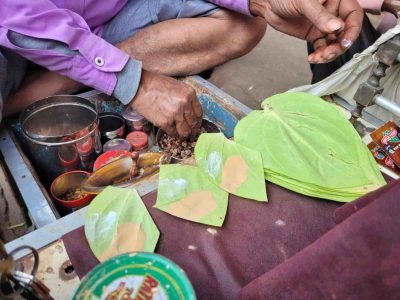
Delhi’s Paan culture
Delhi’s paan culture is deeply intertwined with its rich history and diverse culinary influences, dating back centuries. The Mughal Empire significantly impacted Delhi’s culinary landscape, with paan being enjoyed across social strata, from Mughal courts to the common people. The introduction of various ingredients and preparation styles likely began during this period.
“Delhi’s paan culture reflects the city’s diverse population. You’ll find paan variations influenced by regional preferences from across India—each with unique ingredients and flavours. Some shops specialise in particular types, like meetha paan (sweet), maghai paan (from Magadh region), or sada paan (plain),” says Muchhad paanwala, who sells paans from his glittering shop outside Odeon Picture Hall in Connaught Place.
In recent decades, paan shops have adapted to changing tastes, incorporating modern ingredients like fruits and chocolate. Even today, paan remains socially significant in Delhi, offered as a gesture of hospitality, served after meals, or enjoyed as a digestive aid. The ritual of consuming paan—the preparation, serving, and flavours—adds to its cultural importance.
Also read: Over 20,000 complaints received by Delhi’s Green War Room; GRAP-IV violations see an uptick
The fading charm of Paanwalas
Craving a delicious paan after a satisfying lunch or dinner in Connaught Place, Karol Bagh, or Central Market, Lajpat Nagar? Finding a paanwala who makes paan to your liking in these places will be difficult. It’s not that paanwalas have disappeared—they are there, but they aren’t making paans. They no longer stock catechu, lime, areca nut, cardamom, gulukand, or fennel seeds. Instead, they mainly sell cigarettes and paan masala, having stopped selling paans. A former paanwala near Regal mentioned that selling paans requires much effort, while selling cigarettes and masala is much easier. Besides, the traditional paan-eating clientele is gone.
Many paanwalas now sell tobacco, cigarettes, paan masala, gutkha, hookah, and cheroots near schools, colleges, coaching centres, and government offices in Delhi. Without paans, these vendors no longer attract paan lovers gathering to gossip. The old charm of paan shops, where people stood around discussing current affairs and forming connections, has largely disappeared.
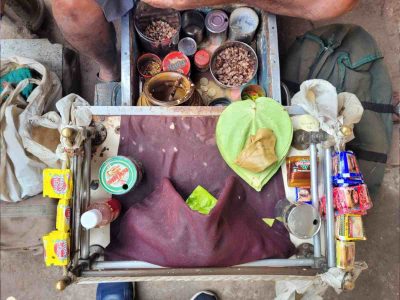
Yet, despite these changes, the spirit of Delhi’s paanwalas persists in pockets across the city. Those who still craft paans with care are keeping a rich tradition alive, one that has been an integral part of the city’s social fabric for centuries. The culture may be fading, but its stories and flavours continue to leave an indelible mark on Delhi’s identity.
The writer is a Delhi-based senior journalist and author of two books ‘Gandhi’s Delhi: April 12, 1915-January 30, 1948 and Beyond’ and ‘Dilli Ka Pehla Pyar – Connaught Place

